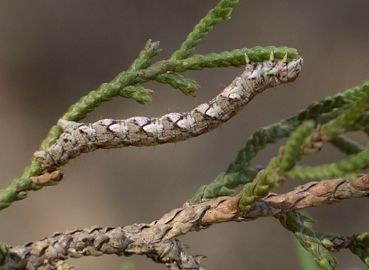 a juniper feeding inchworm, complete with bark-like pattern | 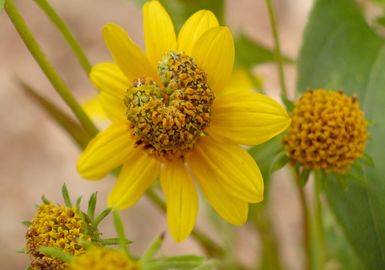 the center of that flower is actually a caterpillar! |
Somewhere along the line, life got complicated. Like mildew growing in your bathroom, it diversified to fill every nook and cranny available. This also included exploiting every energy source possible, so different types of organisms evolved to feed on anything that is even remotely edible. Plants developed defenses that helped them avoid being eaten, but animals overcame those. There are creatures capable of digesting not only tender shoots, but tough mature leaves, dead wood, and poisonous sap. And animals didn't stop with plants. There are other things that can serve as fuel if one's physiology can take it. What is one critter's waste is another's banquet. No species' digestive system is 100% efficient, so what comes out in the end still has some nutritional value. Just look at how dogs relish cat scat, deer droppings, and horse manure. And once an animal dies, it is a cache of resources ready to be utilized. So why wait for the creature to die? Why not just grab a bite on the hoof, while it's still fresh? Predation is the solution.
 a juniper feeding inchworm, complete with bark-like pattern |  the center of that flower is actually a caterpillar! |
With every kind of organism attempting to survive by eating other organisms, the arms race is intense. Not only do plants have their protections, but all animals must also do the same. Every being is a potential meal; those that are alive today have reached that privileged state because they are well adapted to their environments. The faunal community provides a wealth of strategies for eating without being eaten. Stingers, teeth, claws, venomous fangs, poisonous spines, and sequestered toxins are all effective protections. The ability to run, jump, fly, burrow, or swim away also works well. Having a means of scaring off an attacker is certainly effective too, so mimicking more dangerous creatures is another approach. Just doing or producing something startling or repugnant at the moment of attack might buy enough time for the target to escape.
Hiding under rocks, building retreats, or keeping to dark places are yet more survival tactics. But what if you must leave the safe haven to go out and eat? It would be nice to go about the business of feeding, mating, and just moving about without having to worry about being seen. There is no magical invisibility cloak, but there is the next best thing: camouflage.
There are examples of incredible camouflage in every corner of the animal kingdom, such as the hatchlings of ground-nesting birds on a leafy forest floor, lizards in their rocky habitats, and octopuses on a coral reef. Some of the most impressive examples of "hiding in plain sight" occur, though, in the phylum Arthropoda, especially amongst the terrestrial insects and spiders.
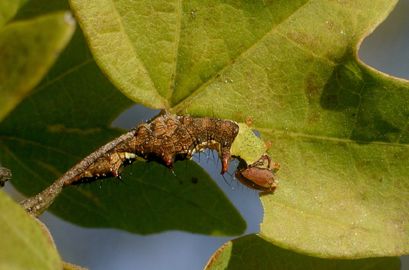 an autumn leaf that is not turning brown on its own | 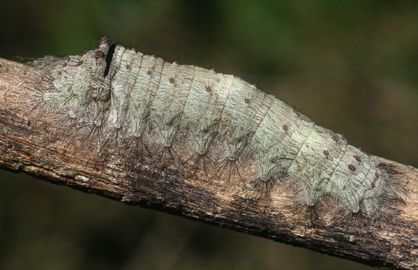 fringe blends the caterpillar right into the branch |
A distinction between mimicry and camouflage needs to be clarified. The former encompasses all kinds of masquerades, including those that are meant to be seen, such as a black and yellow moth that resembles a wasp, or a tasty soldier beetle that sports the red and black colors of a toxic firefly. The purpose of the latter is to NOT be seen. Camouflage only works against a background, and the idea is to blend in. A creature might mimic a stick or stone, but the end result is camouflage because it then looks just like all the other sticks and stones in the area.
It is obvious that not all insects need camouflage. Bees, wasps, and ants have such good defenses that they instead advertise their presence with bold colors, warning potential hunters that they can take care of themselves. The same is true for those true bugs, moths, and flies that mimic them. Fast moving creatures also rely very little on being hidden. After all, movement certainly blows the cover!
Caterpillars are undoubtedly the Kings of Camouflage. As a (very large) group, lepidopteran larvae are slow moving and soft morsels of protein. Only a few have defenses such as toxic flesh or evasive behaviors. During the nesting season, many species of birds rely heavily on caterpillars to feed their broods. Birds have excellent color vision, and their acuity for detail is astounding. Given that they also forage for hours every day, finding and consuming hundreds of insects, their influence on caterpillar evolution cannot be overestimated. Other predators, such as lizards, spiders, beetles, wasps, and assassin bugs also take their toll.
 a chilled orange sulphur waiting for the sun | 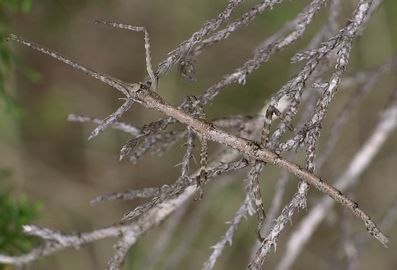 a tangle of twigs and stick insect |
While some caterpillars are generalists and can feed on a wide variety of different plants, the vast majority are specialists and only feed on a particular type. This makes sense not only because the larva then has established solutions to such challenges as specific toxicity and seasonal availability, but it is also less likely to be eaten before maturity if it looks like the species on which it dines. There are even certain caterpillars that specialize in either spring or autumn foliage, and they would not survive at the opposite season.
The ways in which caterpillars can blend into their host plants are mind-boggling. Some are simply green - but with the exact hue and texture of the leaves on which they feed. Others match the bark of their plant. These often rest on the matching twigs or branches during the day and then move about to feed under the cover of darkness. Just having the right color is not always enough. One way of hiding is to mask the outline where insect meets plant. Some caterpillars have a fringe of hairs that obscures the shadow that would have been cast as they perch on a branch. Others have brown patches and strange bumps and protuberances so that they look like a leaf that has a bit of damage or is partly dead. Some species chew out a part of a leaf and then place their body in such a way as to mimic the missing bit.
People often ask me what butterflies do at night, or when it rains or is cold. The answer is not surprising: they just sit tight and wait. In cool weather, a butterfly's flight muscles just do not work, so it must avoid detection rather than fly away. While swarming around flowers on a warm sunny day, butterflies are so obvious that it is hard to imagine NOT noticing them. However, try looking at the same flower patches when the temperature is below 50°F and you will be hard pressed to see any at all. They are still there, yet their choices of perch are often determined by how well they will match.
 granite-colored grasshopper nymph |  crab spider waiting for dinner |
Other herbivorous insects also display great examples of camouflage. Walkingsticks, or stick insects, are slow-moving arboreal animals that have no defenses other than to just remain undetected. But, as their name implies, they do that superbly. Some species of walkingsticks are variable in their color, with some individuals being more brown or more green. I rarely find one, though, that is not on a matching background. If I could see it, it is likely that a bird or other predator would have found it first!
Another group of insects that rely on their habitat-like disguise is the grasshopper family. Often residing in open grassy fields or rocky landscapes, these diurnal herbivores are exceedingly edible. They can usually jump or fly, but they are not built for long distance chases and quickly tire. Once they land, they stay perfectly still and voila! They are invisible!
It might come as a surprise that spiders frequently use camouflage. Many humans are so creeped out by arachnids that it is a bit of a stretch to realize that there are animals that might want to eat them. But that is the case, and the camouflage of a sedentary predator not only keeps it safe from birds, shrews, lizards or wasps that might eat it, but it also conceals it from its own prey. Any search of a typical flower garden will usually turn up a crab spider or two. These ambush hunters often match their blossoms so well that they are found by looking for a dead bee or fly that they are consuming rather than for the actual spider. Not all orbweavers stay in their characteristic webs during the day. Instead, many retreat to a little hideout at the base of one of the anchor strands and wait until nightfall before venturing back out into the open. It is not unusual to find a web, minus the spider, that has a large hole right in the middle, where a bird had found an easy snack.
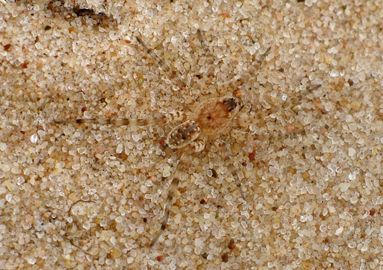 hiding on sand is easy if you have the right pattern | 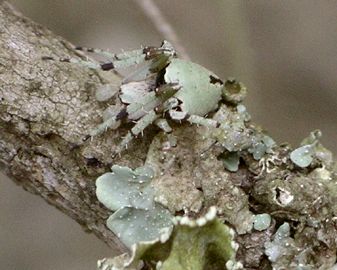 an orbweaver that mimics the lichens of its habitat |
So how do you find something that is doing an admirable job of being undetectable? It is very entertaining to seek out and discover the hidden inhabitants in our environment, but it certainly does take some practice and patience. A useful technique, that works with grasshoppers and moths out in fields, is to scare them up and then watch very carefully where they land. Even that will not guarantee success, but it certainly increases the odds that the bug will eventually be found. Good eyesight works wonders, but it is also necessary to learn to recognize clues that will lead to these cryptic members of the fauna. An additional tool in our repertoire is to learn what lives where. Just knowing that crab spiders live in flowers, caterpillars often stay on their host plants, and katydids prefer to hang out amidst the foliage they resemble, will help narrow the search for hidden critters. One more aspect of this endeavor is our ability to remember patterns and discern anomalies within a familiar situation. Our eyes might not be the best in the animal kingdom, but our big brains make us more clever than average at the hide and seek game.